Sustainability Identification of Steel and Concrete Construction Frames with Respect to Triple Bottom Line
Abstract
:1. Introduction
2. Methodology and Case Study
2.1. Introducing Case Study
2.2. Life Cycle Assessment (LCA)
2.2.1. Goal and Scope Definition
2.2.2. Results of Life Cycle Impacts
2.3. Life Cycle Cost (LCC) Analysis
2.3.1. Problem Definition
2.3.2. Cost Breakdown Analysis
2.3.3. System Modeling
- Ct = The sum of total costs that occur in period t,
- N = Number of periods under study,
- r = discount rate (interest rate).
2.3.4. Data Collection
2.3.5. Cost Estimates
2.3.6. Evaluation
2.4. Social Life Cycle Assessment (S-LCA)
2.4.1. Goal, Scope, and System Boundary
2.4.2. Inventory Analysis
2.4.3. Impact Assessment
Best Worst Method
- Step 1: Selecting the decision criteria. In this step, a set of factors {c1, c2, c3,....., cn} is determined to be considered in decision making.
- Step 2: The decision makers select the best/most significant and the worst/least significant criteria in this step.
- Step 3: To select the best criteria and its preference over other factors, decision makers must assign a number between 1 and 9 to each measure. This step’s results are called Best-to-Others and are shown as AB = (aB1, aB2,...., aBn), where aBj shows the preference of the best criterion B over criterion j, and it could be concluded that aBB = 1.
- Step 4: In this step, the worst criteria should be selected, and the preference of other factors over the worst criteria needs to be determined. Similar to step 3, assigning numbers between 1 and 9 should also be used in this step. The results in this step are called Others-to-Worst and shown as Aw = (a1w, a2w,....., anw)T, where ajw shows the preference of the criterion j over the worst criterion w, and it is evident that aww = 1.
- Step 5: The optimal weights (w1*, w2*, w3*,....., wn*) should be calculated. The weight is optimal where for each pair of wB/wj and wj/ww, we have wB/wj = aBj and wj/ww = ajw. Therefore, to reach optimality, we need to minimize the maximum absolute differences of {|wB − aBjwj|, |wj − ajwww|}, which can be formulated as follows:
Results
2.4.4. Interpretation
2.5. Multi-Criteria Assessment and Sensitivity Analysis
2.5.1. Triangle Graph
2.5.2. Results
3. Discussion
4. Conclusions
Author Contributions
Funding
Conflicts of Interest
References
- Klöpffer, W. Life cycle sustainability assessment of products. Int. J. Life Cycle Assess. 2008, 13, 89–95. [Google Scholar] [CrossRef]
- United Nations Environmental Programme, Sustainable Buildings and Climate Initiative. Buildings and Climate Change: Summary for Decision-Makers; United Nations Environmental Programme: Paris, France, 2009; pp. 1–62. [Google Scholar]
- Vieira, P.S.; Horvath, A. Assessing the End-Of-Life Impacts of Buildings; ACS Publications: Washington, DC, USA, 2008; pp. 4663–4669. [Google Scholar]
- Mavrokapnidis, D.; Mitropoulou, C.C.; Lagaros, N.D. Environmental assessment of cost optimized structural systems in tall buildings. J. Build. Eng. 2019, 24, 100730. [Google Scholar] [CrossRef] [Green Version]
- Balasbaneh, A.T.; Marsono AK, B.; Kermanshahi, E.K. Balancing of life cycle carbon and cost appraisal on alternative wall and roof design verification for residential building. Constr. Innov. 2018, 18, 274–300. [Google Scholar] [CrossRef]
- Val, D.V.; Stewart, M.G. Life-cycle cost analysis of reinforced concrete structures in marine environments. Struct. Saf. 2003, 25, 343–362. [Google Scholar] [CrossRef]
- Lu, H.R.; El Hanandeh, A.; Gilbert, B.P. A comparative life cycle study of alternative materials for Australian multi-storey apartment building frame constructions: Environmental and economic perspective. J. Clean. Prod. 2017, 166, 458–473. [Google Scholar] [CrossRef]
- Hosseinijou, S.A.; Mansour, S.; Shirazi, M.A. Social life cycle assessment for material selection: A case study of building materials. Int. J. Life Cycle Assess. 2014, 19, 620–645. [Google Scholar] [CrossRef]
- Akadiri, P.O.; Chinyio, E.A.; Olomolaiye, P.O. Design of a sustainable building: A conceptual framework for implementing sustainability in the building sector. Buildings 2012, 2, 126–152. [Google Scholar] [CrossRef] [Green Version]
- Cabeza, L.F.; Rincón, L.; Vilariño, V.; Pérez, G.; Castell, A. Life cycle assessment (LCA) and life cycle energy analysis (LCEA) of buildings and the building sector: A review. Renew. Sustain. Energy Rev. 2014, 29, 394–416. [Google Scholar] [CrossRef]
- Reza, B.; Sadiq, R.; Hewage, K. Sustainability assessment of flooring systems in the city of Tehran: An AHP-based life cycle analysis. Constr. Build. Mater. 2011, 25, 2053–2066. [Google Scholar] [CrossRef]
- Akadiri, P.O.; Olomolaiye, P.O.; Chinyio, E.A. Multi-criteria evaluation model for the selection of sustainable materials for building projects. Autom. Constr. 2013, 30, 113–125. [Google Scholar] [CrossRef]
- Balasbaneh, A.T.; Marsono AK, B.; Khaleghi, S.J. Sustainability choice of different hybrid timber structure for low medium cost single-story residential building: Environmental, economic and social assessment. J. Build. Eng. 2018, 20, 235–247. [Google Scholar] [CrossRef]
- Xing, S.; Xu, Z.; Jun, G. Inventory analysis of LCA on steel-and concrete-construction office buildings. Energy Build. 2008, 40, 1188–1193. [Google Scholar] [CrossRef]
- Kim, S.; Moon, J.H.; Shin, Y.; Kim, G.H.; Seo, D.S. Life comparative analysis of energy consumption and CO2 emissions of different building structural frame types. Sci. World J. 2013, 2013, 175702. [Google Scholar] [CrossRef] [Green Version]
- Robertson, A.B.; Lam, F.C.; Cole, R.J. A comparative cradle-to-gate life cycle assessment of mid-rise office building construction alternatives: Laminated timber or reinforced concrete. Buildings 2012, 2, 245–270. [Google Scholar] [CrossRef]
- Dimoudi, A.; Tompa, C. Energy and environmental indicators related to construction of office buildings. Resour. Conserv. Recycl. 2008, 53, 86–95. [Google Scholar] [CrossRef]
- Junnila, S.; Horvath, A.; Guggemos, A.A. Life-cycle assessment of office buildings in Europe and the United States. J. Infrastruct. Syst. 2006, 12, 10–17. [Google Scholar] [CrossRef]
- Kahhat, R.; Crittenden, J.; Sharif, F.; Fonseca, E.; Li, K.; Sawhney, A.; Zhang, P. Environmental impacts over the life cycle of residential buildings using different exterior wall systems. J. Infrastruct. Syst. 2009, 15, 211–221. [Google Scholar] [CrossRef]
- Ge, J.; Yan, Y.; Lu, J.; Wang, J. Chinese energy/CO2 intensities based on 2002 input-output table and Life Cycle Assessment of residential building by accumulative method. Lowl. Technol. Int. 2010, 12, 14–22. [Google Scholar]
- Utama, A.; Gheewala, S.H. Indonesian residential high rise buildings: A life cycle energy assessment. Energy Build. 2009, 41, 1263–1268. [Google Scholar] [CrossRef]
- Broun, R.; Menzies, G.F. Life cycle energy and environmental analysis of partition wall systems in the UK. Procedia Eng. 2011, 21, 864–873. [Google Scholar] [CrossRef] [Green Version]
- Sinha, R.; Lennartsson, M.; Frostell, B. Environmental footprint assessment of building structures: A comparative study. Build. Environ. 2016, 104, 162–171. [Google Scholar] [CrossRef]
- Emami, N.; Heinonen, J.; Marteinsson, B.; Säynäjoki, A.; Junnonen, J.M.; Laine, J.; Junnila, S. A life cycle assessment of two residential buildings using two different LCA database-software combinations: Recognizing uniformities and inconsistencies. Buildings 2019, 9, 20. [Google Scholar] [CrossRef] [Green Version]
- Asdrubali, F.; Baldassarri, C.; Fthenakis, V. Life cycle analysis in the construction sector: Guiding the optimization of conventional Italian buildings. Energy Build. 2013, 64, 73–89. [Google Scholar] [CrossRef]
- Ximenes, F.A.; Grant, T. Quantifying the greenhouse benefits of the use of wood products in two popular house designs in Sydney, Australia. Int. J. Life Cycle Assess. 2013, 18, 891–908. [Google Scholar] [CrossRef]
- Babaizadeh, H.; Hassan, M. Life cycle assessment of nano-sized titanium dioxide coating on residential windows. Constr. Build. Mater. 2013, 40, 314–321. [Google Scholar] [CrossRef]
- Kofoworola, O.F.; Gheewala, S.H. Life cycle energy assessment of a typical office building in Thailand. Energy Build. 2009, 41, 1076–1083. [Google Scholar] [CrossRef]
- Scheuer, C.; Keoleian, G.A.; Reppe, P. Life cycle energy and environmental performance of a new university building: Modeling challenges and design implications. Energy Build. 2003, 35, 1049–1064. [Google Scholar] [CrossRef]
- Cole, R.J. Energy and greenhouse gas emissions associated with the construction of alternative structural systems. Build. Environ. 1998, 34, 335–348. [Google Scholar] [CrossRef]
- Mithraratne, N.; Vale, B. Life cycle analysis model for New Zealand houses. Build. Environ. 2004, 39, 483–492. [Google Scholar] [CrossRef]
- Reddy, B.V.; Jagadish, K.S. Embodied energy of common and alternative building materials and technologies. Energy Build. 2003, 35, 129–137. [Google Scholar] [CrossRef]
- Thormark, C. Environmental analysis of a building with reused building materials. Int. J. Low Energy Sustain. Build. 2000, 1, 1–19. [Google Scholar]
- Nässén, J.; Hedenus, F.; Karlsson, S.; Holmberg, J. Concrete vs. wood in buildings—An energy system approach. Build. Environ. 2012, 51, 361–369. [Google Scholar] [CrossRef]
- Balasbaneh, A.T.; Ramli, M.Z. A comparative life cycle assessment (LCA) of concrete and steel-prefabricated prefinished volumetric construction structures in Malaysia. Environ. Sci. Pollut. Res. 2020, 27, 43186–43201. [Google Scholar] [CrossRef]
- Gervasio, H. Comparative Housing Case Study (Steel vs. Concrete) through a Quantitative Life Cycle Approach, 2nd ed.; World Steel Construction Council: Brussels, Belgium, 2007. [Google Scholar]
- Oladazimi, A.; Mansour, S.; Hosseinijou, S.A. Comparative Life Cycle Assessment of Steel and Concrete Construction Frames: A Case Study of Two Residential Buildings in Iran. Buildings 2020, 10, 54. [Google Scholar] [CrossRef] [Green Version]
- ISO. DIS 15686-5 Buildings and Constructed Assets-Service Life Planning; International Organization for Standardization: Geneva, Switzerland, 2017. [Google Scholar]
- UNEP. Guidelines for Social Life Cycle Assessment of Products; United Nations Environment Programme (UNEP) and Society of Environmental Toxicology and Chemistry (SETAC): Brussels, Belgium, 2009. [Google Scholar]
- Elkington, J. Partnerships from cannibals with forks: The triple bottom line of 21st-century business. Environ. Qual. Manag. 1998, 8, 37–51. [Google Scholar] [CrossRef]
- International Organization for Standardization. ISO 14044-Environmental management—Life Cycle Assessment—Principle and Framework. 2006. Available online: https://www.iso.org/standard/38498.html (accessed on 26 September 2021).
- Kawauchi, Y.; Rausand, M. Life Cycle Cost (LCC) Analysis in Oil and Chemical Process Industries; Toyo Engineering Corp: Chiba, Japan, 1999. [Google Scholar]
- Ciroth, A. Software for life cycle assessment. In Life Cycle Assessment Handbook; John Wiley & Sons, Inc.: Hoboken, NJ, USA, 2012; pp. 143–157. [Google Scholar]
- Cole, R.J.; Sterner, E. Reconciling theory and practice of life-cycle costing. Build. Res. Inf. 2000, 28, 368–375. [Google Scholar] [CrossRef]
- Gluch, P.; Baumann, H. The life cycle costing (LCC) approach: A conceptual discussion of its usefulness for environmental decision-making. Build. Environ. 2004, 39, 571–580. [Google Scholar] [CrossRef] [Green Version]
- Langdon, D. Life Cycle Costing (LCC) as a Contribution to Sustainable Construction: A Common Methodology; Literature Review; Davis Langdon Management Consulting: London, UK, 2007. [Google Scholar]
- Task Group 4 (TG4) Report of Task Group 4: Life Cycle Costs in Construction, the European Commission. 2003. Available online: http://ec.europa.eu/enterprise/construction/suscon/tgs/tg4/lccreport.pdf (accessed on 26 September 2021).
- Jørgensen, A. Developing the Social Life Cycle Assessment: Addressing Issues of Validity and Usability; DTU Management: Kongens Lyngby, Denmark, 2010. [Google Scholar]
- Méthot, A. FIDD: A green and socially responsible venture capital fund. In Proceedings of the Life Cycle Approaches for Green Investment—26th LCA Swiss Discussion Forum, Lausanne, Switzerland, 7 June 2005. [Google Scholar]
- Dreyer, L.; Hauschild, M.; Schierbeck, J. A framework for social life cycle impact assessment (10 pp). Int. J. Life Cycle Assess. 2006, 11, 88–97. [Google Scholar] [CrossRef]
- Benoît, C.; Norris, G.A.; Valdivia, S.; Ciroth, A.; Moberg, A.; Bos, U.; Prakash, S.; Ugaya, C.; Beck, T. The guidelines for social life cycle assessment of products: Just in time! Int. J. Life Cycle Assess. 2010, 15, 156–163. [Google Scholar] [CrossRef]
- Ahmadi, H.B.; Kusi-Sarpong, S.; Rezaei, J. Assessing the social sustainability of supply chains using Best Worst Method. Resour. Conserv. Recycl. 2017, 126, 99–106. [Google Scholar] [CrossRef]
- Rezaei, J. Best-worst multi-criteria decision-making method: Some properties and a linear model. Omega 2016, 64, 126–130. [Google Scholar] [CrossRef]
- Hofstetter, P.; Braunschweig, A.; Mettier, T.; Müller-Wenk, R.; Tietje, O. The mixing triangle: Correlation and graphical decision support for LCA-based comparisons. J. Ind. Ecol. 1999, 3, 97–115. [Google Scholar] [CrossRef]
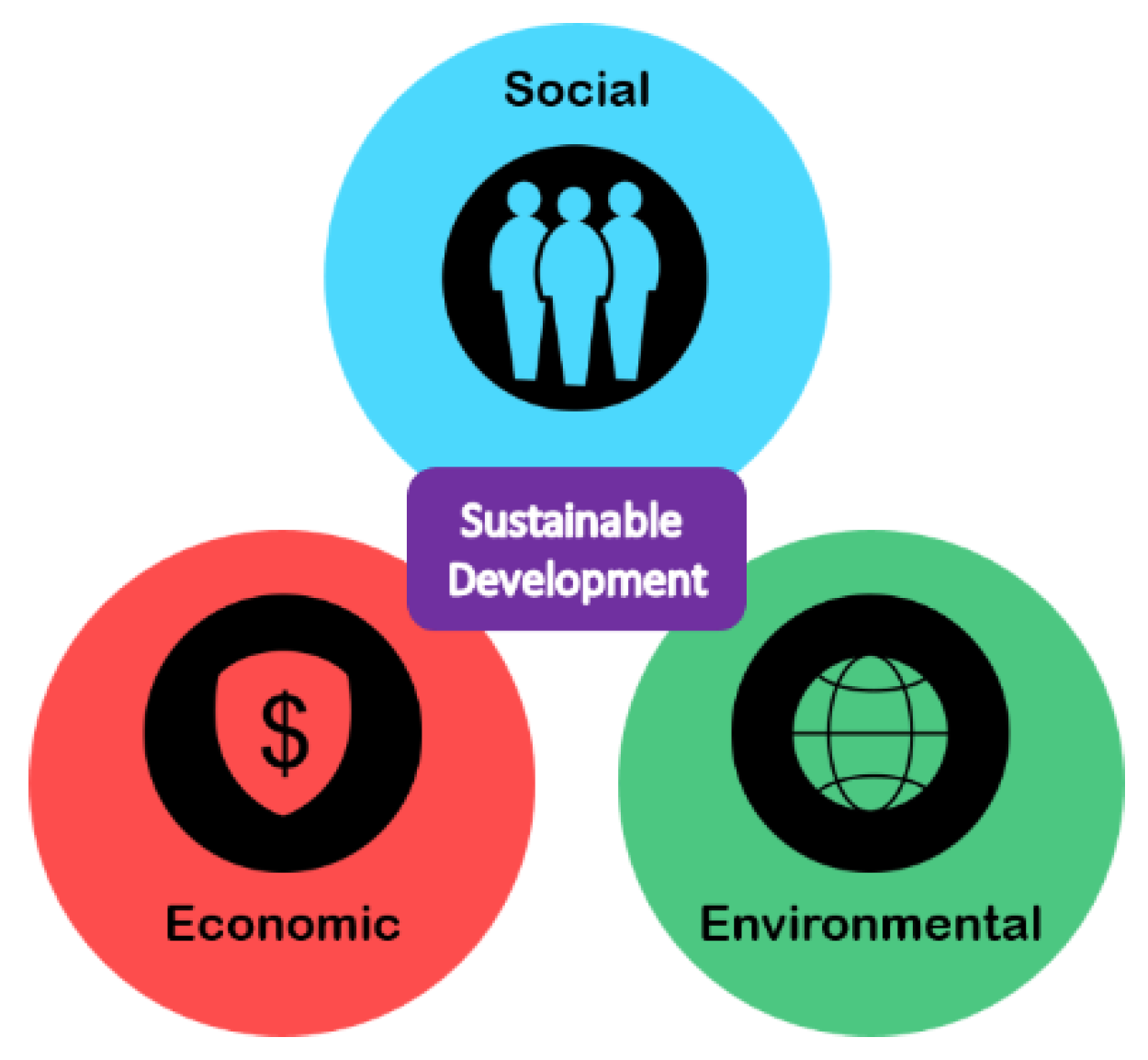
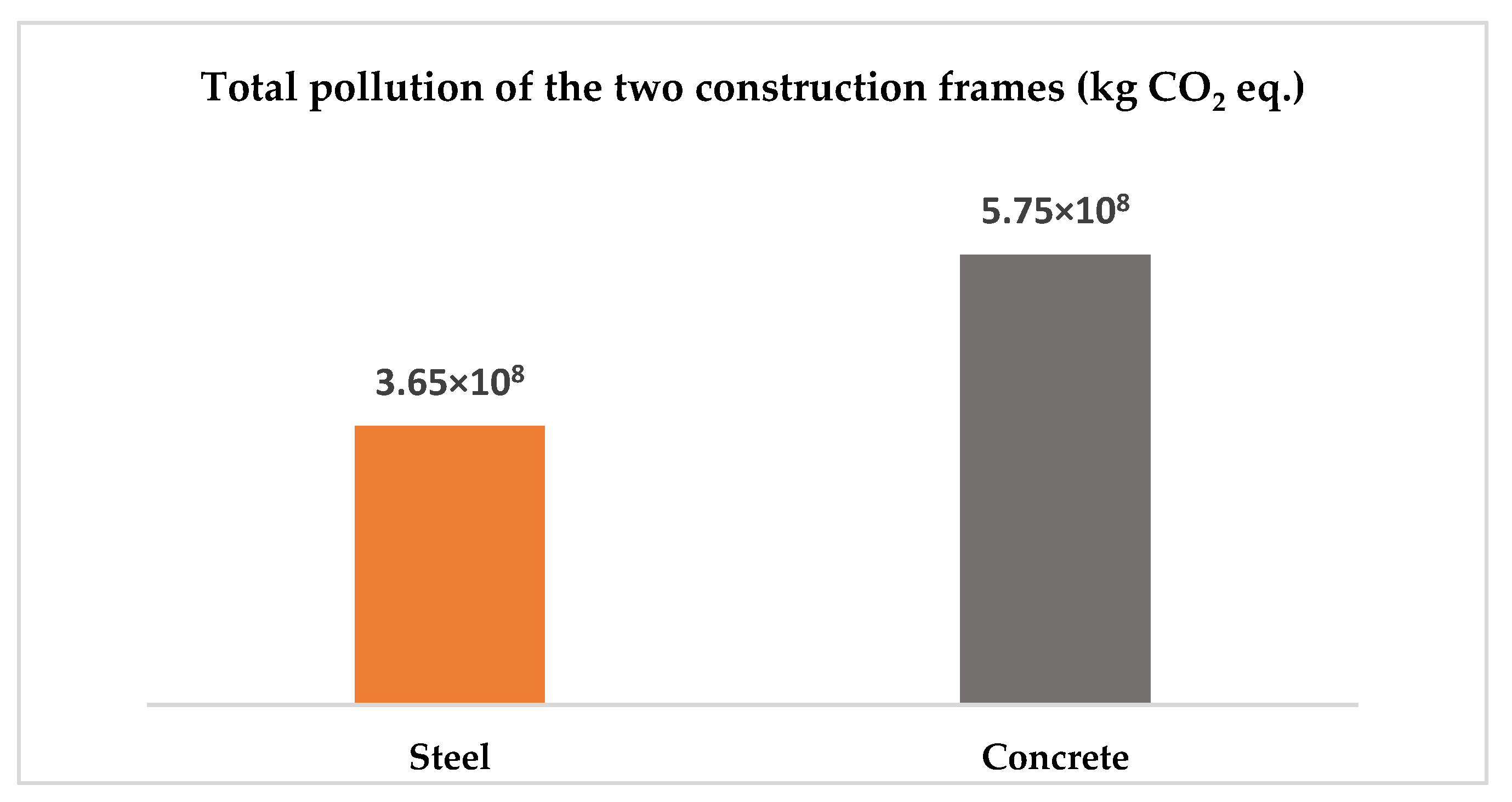

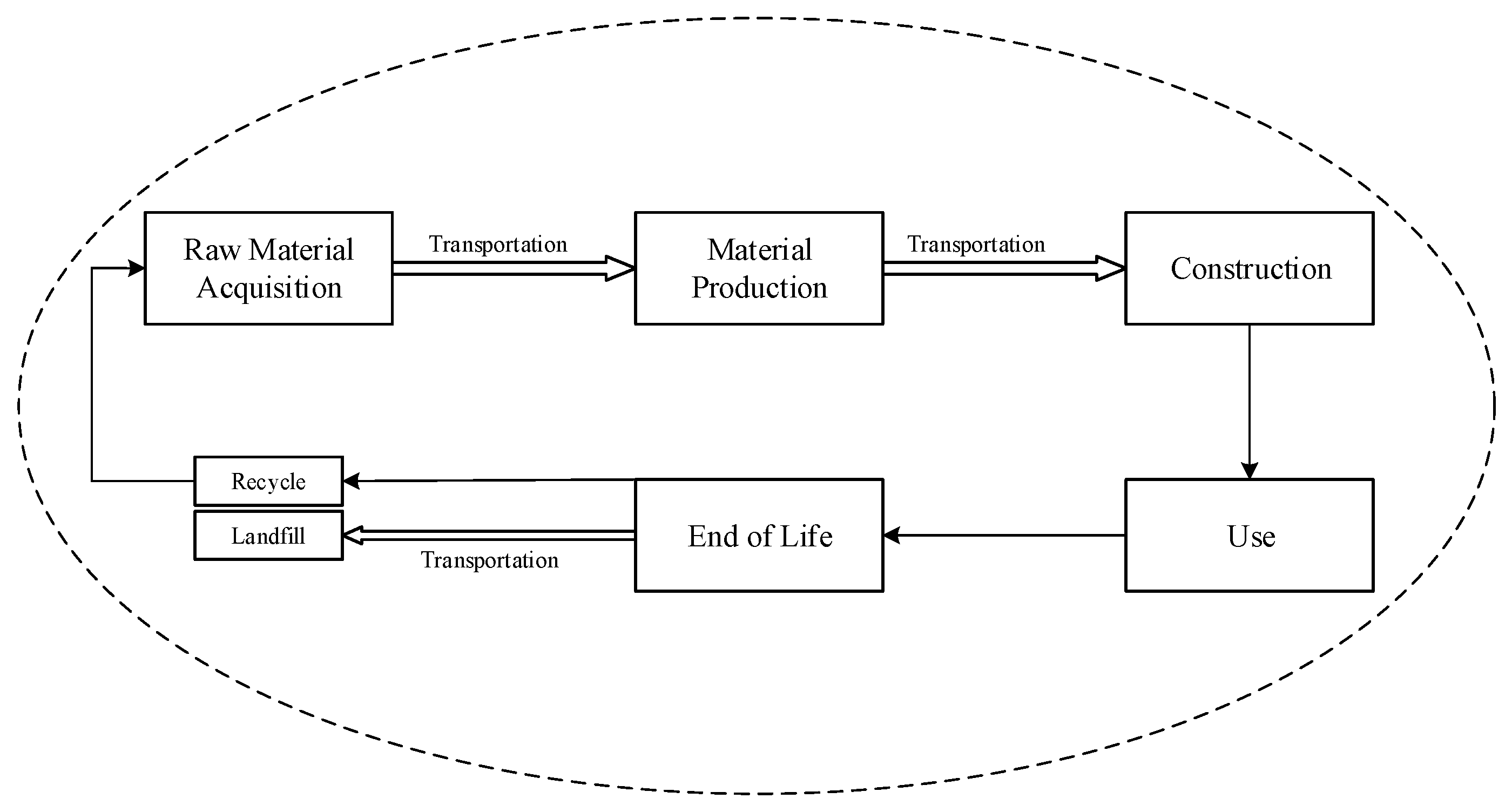

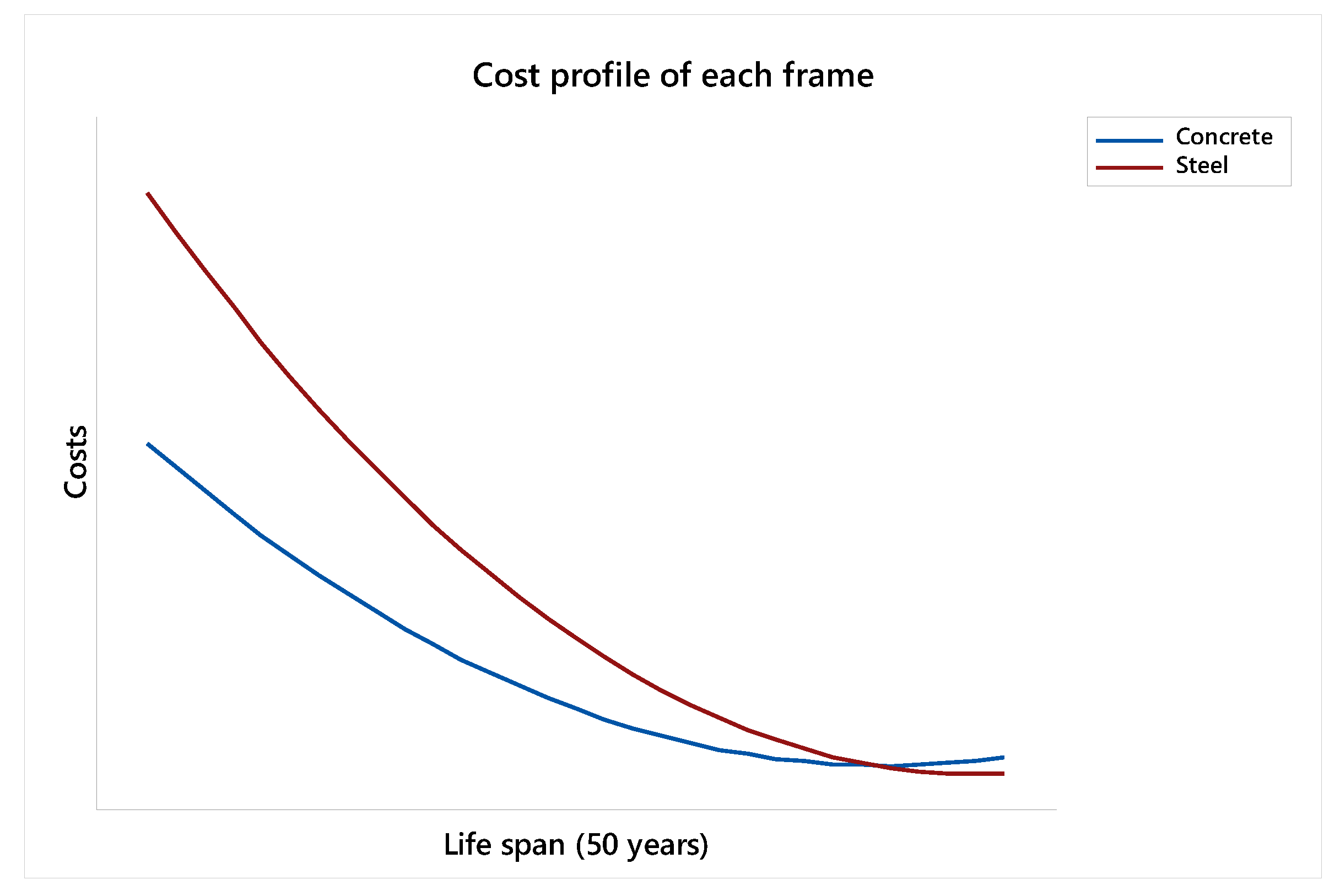


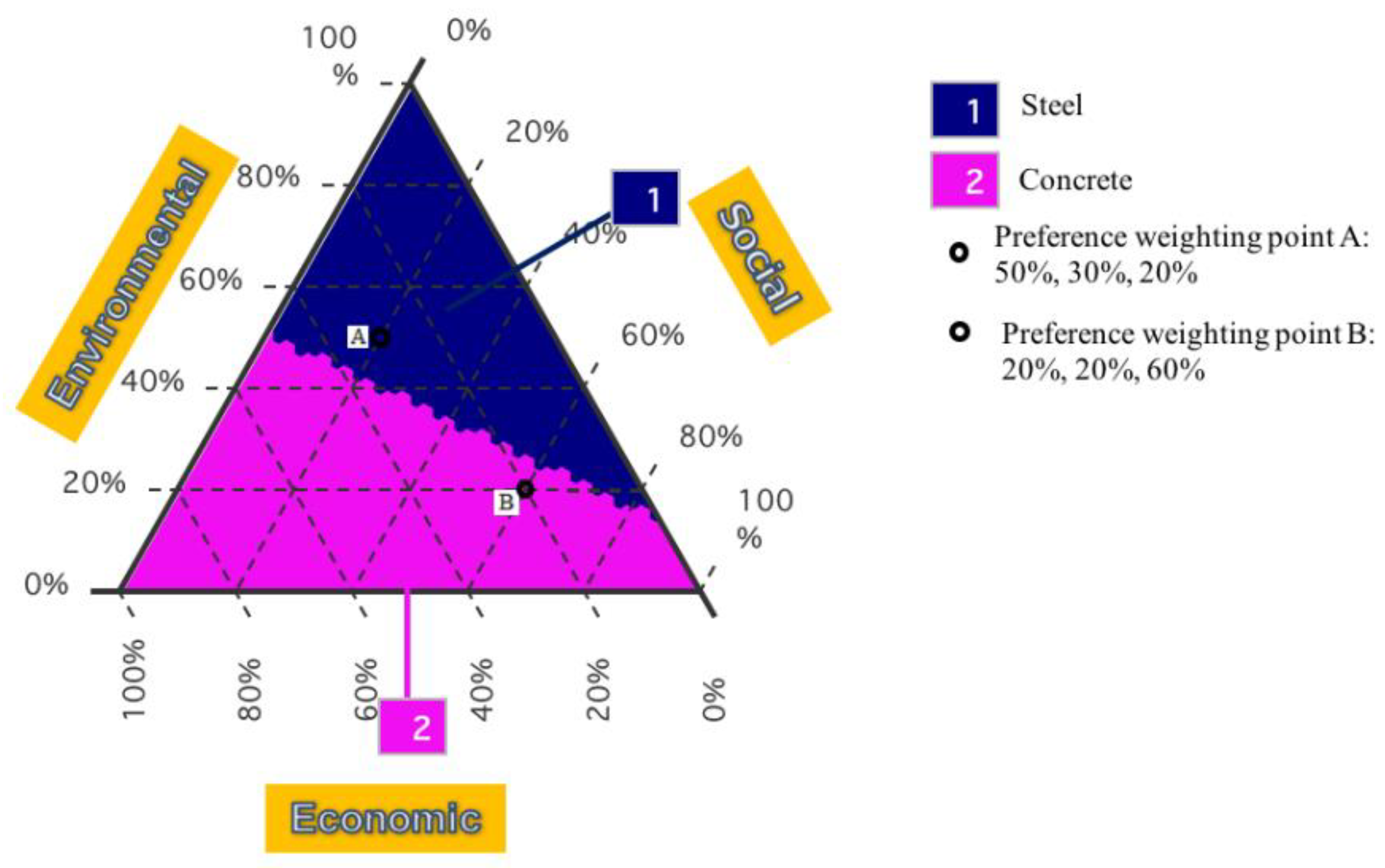
| Authors | Case Study | Dimensions/Methodology | Multi-Criteria Assessment | ||||
|---|---|---|---|---|---|---|---|
| Country | Alternative Materials | Structures | Environmental | Economic | Social | ||
| Vieira et al. (2008) [3] | USA | Concrete | Office building | LCA | -- | -- | -- |
| Balasbaneh et al. (2018) [5] | Malaysia | Wood, Steel, Brick, Concrete | Single-storey building | LCA | LCC | -- | -- |
| Val et al. (2003) [6] | Australia | Reinforced Concrete | Residential building | -- | LCC | -- | -- |
| Lu et al. (2017) [7] | Australia | Concrete, Steel, Laminated Veneer Lumber | Multi-storey apartment | LCA | LCC | -- | -- |
| Hosseinijou et al. (2014) [8] | Iran | Concrete, Steel | Building materials | -- | -- | S-LCA | -- |
| Reza el al (2011) [11] | Iran | Concrete, Clay, expanded polystyrene | Building materials, flooring systems | AHP based LCA | AHP | AHP | AHP |
| Akadiri et al. (2013) [12] | UK | Timber | Office building | FEAHP | FEAHP | FEAHP | -- |
| Balasbaneh et al. (2018) [13] | Malaysia | Concrete, Steel, Timber | Residential building | LCA | LCC | S-LCA (no quantitative method) | -- |
| Xing et al. (2008) [14] | China | Concrete, Steel | Office building | LCA | -- | -- | -- |
| Kim et al. (2013) [15] | Republic of Korea | Reinforced Concrete, Steel | Construction materials | Input/output analysis | -- | -- | -- |
| Robertson et al. (2012) [16] | Canada | Laminated Timber, Reinforced Concrete | Office building | LCA | -- | -- | -- |
| Dimoudi et al. (2008) [17] | Greece | Concrete, Reinforcement steel | Office building | LCA | -- | -- | -- |
| Junnila et al. (2006) [18] | USA, Finland | Miscellaneous building materials | Office building | LCA | -- | -- | -- |
| Kahhat et al. (2009) [19] | USA | Concrete, Block, Wood, Steel | Residential building | LCA | -- | -- | -- |
| Ge et al. (2010) [20] | China | Concrete, Steel | Residential building | LCA | -- | -- | -- |
| Utama et al. (2009) [21] | Indonesia | Double and Single Walls | Tall buildings | LCA | -- | -- | -- |
| Broun et al. (2011) [22] | UK | Brick, Clay, Concrete, Timber | Partition walls | LCA | -- | -- | -- |
| Sinha et al. (2016) [23] | Sweden | Concrete, Wood | Residential building | LCA | -- | -- | -- |
| Emami et al. (2019) [24] | Finland | Concrete, Wood | Residential building | LCA | -- | -- | -- |
| Asdrubali et al. (2013) [25] | Italy | Reinforced Concrete | Residential house and office building | LCA | -- | -- | -- |
| Ximenes et al. (2013) [26] | Australia | Miscellaneous building materials | Domestic house | LCA | -- | -- | -- |
| Babaizadeh et al. (2013) [27] | USA | Titanium Dioxide Coating | Building materials | LCA | -- | -- | -- |
| Kofoworola et al. (2009) [28] | Thailand | Miscellaneous building materials | Office building | LCA | -- | -- | -- |
| Scheuer et al. (2003) [29] | USA | Miscellaneous building materials | University building | LCA | -- | -- | -- |
| Cole (1998) [30] | Canada | Concrete, Steel, Wood | Construction materials | LCA | -- | -- | -- |
| Mithraratne et al. (2004) [31] | New Zealand | Miscellaneous building materials | Light-weight timber framed house and concrete timber house | LCA | LCC | -- | -- |
| Venkatarama et al. (2003) [32] | India | Miscellaneous building materials | Building materials | LCA | -- | -- | -- |
| Thormark (2000) [33] | Sweden | Miscellaneous building materials | Single dwelling | LCA | -- | -- | -- |
| Nässén et al. (2012) [34] | Sweden | Concrete, Wood | Four-storey building | carbon balances | Net present cost | -- | -- |
| This study | Iran | Steel, Concrete | Building frames | LCA | LCC | SLCA | Mixing Triangle |
| Title | Variable | Steel | Concrete |
|---|---|---|---|
| Discount rate | i | 15% | 15% |
| life span (Year) | Ln | 50 | 50 |
| Initial Costs (USD Thousands) | |||
| Raw Material Acquisition | MA | 100 | 70 |
| Material Production | MP | 257 | 127 |
| Transportation | Ti | 5 | 2.3 |
| Present Value of Initial Costs | PVIC | 301 | 174 |
| Annual Value of Initial Costs | AVIC | 45 | 26 |
| Construction Costs (USD Thousands) | |||
| Transportation | TC | 4.2 | 2 |
| Construction | C | 90 | 47 |
| Use | U | — | — |
| Present Value of Construction Costs | PVCC | 75 | 39 |
| Annual Value of Construction Costs | AVCC | 11.2 | 5.8 |
| End-of-Life Costs (USD Thousands) | |||
| Demolition | D | 2.8 | 11 |
| Transportation | TEOL | 5.3 | 7.2 |
| Present Value of End-of-Life Costs | PVEOLC | 6.4 | 14.6 |
| Annual Value of End-of-Life Costs | AVEOLC | 1 | 2.1 |
| Present Value of Life Cycle Costs | PVLCC | 380 | 228 |
| Annual Value of Life Cycle Costs | AVLCC | 57.2 | 34.1 |
| Expert’s Number | Profession |
|---|---|
| E-01 | Architect |
| E-02 | Architect |
| E-03 | Architect |
| E-04 | Architect |
| E-05 | Architect |
| E-06 | Structural Engineer |
| E-07 | Structural Engineer |
| E-08 | Structural Engineer |
| E-09 | Earthquake Engineer |
| E-10 | Structural Engineer |
| Social Impact Factors | Selected as Best by Experts | Selected as Worst by Experts |
|---|---|---|
| Health and Safety (w1) | E-06, E-09 | E-07, E-10 |
| Fair salary (w2) | E-02, E-04, E-07, E-10 | E-08 |
| Local employment (w3) | E-03, E-05 | — |
| Local community acceptance (w4) | E-08 | E-01, E-03, E-05, E-06 |
| Extraction of material resources (w5) | E-01 | E-02, E-04, E-09 |
| Social Impact Factors | Selected as Best by Experts | Selected as Worst by Experts |
|---|---|---|
| Health and Safety (w1) | — | E-06, E-08, E-09 |
| Fair salary (w2) | E-02, E-03, E-05, E-07, E-08, E-10 | — |
| Local employment (w3) | — | E-04, E-05 |
| Local community acceptance (w4) | E-01, E-04 | E-03, E-07, E-10 |
| Extraction of material resources (w5) | E-06, E-09 | E-01, E-02 |
| Social Sustainability Criteria | Concrete | Steel | ||
|---|---|---|---|---|
| Mean | s.d. | Mean | s.d. | |
| Health and safety (w1) | 0.192 | 0.158 | 0.11 | 0.046 |
| Fair salary (w2) | 0.282 | 0.158 | 0.307 | 0.162 |
| Local employment (w3) | 0.231 | 0.144 | 0.153 | 0.067 |
| Local community acceptance (w4) | 0.14 | 0.119 | 0.181 | 0.176 |
| Extraction of material resources (w5) | 0.154 | 0.116 | 0.194 | 0.163 |
| Overall Mean | 0.199 | 0.189 | ||
| Average consistency, ξL* | 0.108 | 0.101 | ||
| Non-Normalized | Normalized (in Terms of Sustainability Load) | |||||
|---|---|---|---|---|---|---|
| Options | Environmental (kg CO2 eq.) | Economic (USD Thousands) | Social | Environmental | Economic | Social |
| Steel frame | 3.56 E+ 08 | 380 | 0.189 | 0.61 | 1.00 | 1.00 |
| Concrete frame | 5.75 E+ 08 | 228 | 0.199 | 1.00 | 0.60 | 0.94 |
| Environmental | Economic | Social | Sustainability Scores (Point A) | Sustainability Scores (Point B) | |
|---|---|---|---|---|---|
| Weights (Point A) Weights (Point B) Options | 50% 20% | 30% 20% | 20% 60% | ||
| Steel frame | 0.61 | 1.00 | 1.00 | 0.805 | 0.922 |
| Concrete frame | 1.00 | 0.60 | 0.94 | 0.868 | 0.884 |
Publisher’s Note: MDPI stays neutral with regard to jurisdictional claims in published maps and institutional affiliations. |
© 2021 by the authors. Licensee MDPI, Basel, Switzerland. This article is an open access article distributed under the terms and conditions of the Creative Commons Attribution (CC BY) license (https://creativecommons.org/licenses/by/4.0/).
Share and Cite
Oladazimi, A.; Mansour, S.; Hosseinijou, S.A.; Majdfaghihi, M.H. Sustainability Identification of Steel and Concrete Construction Frames with Respect to Triple Bottom Line. Buildings 2021, 11, 565. https://doi.org/10.3390/buildings11110565
Oladazimi A, Mansour S, Hosseinijou SA, Majdfaghihi MH. Sustainability Identification of Steel and Concrete Construction Frames with Respect to Triple Bottom Line. Buildings. 2021; 11(11):565. https://doi.org/10.3390/buildings11110565
Chicago/Turabian StyleOladazimi, Amir, Saeed Mansour, Seyed Abbas Hosseinijou, and Mohammad H. Majdfaghihi. 2021. "Sustainability Identification of Steel and Concrete Construction Frames with Respect to Triple Bottom Line" Buildings 11, no. 11: 565. https://doi.org/10.3390/buildings11110565
APA StyleOladazimi, A., Mansour, S., Hosseinijou, S. A., & Majdfaghihi, M. H. (2021). Sustainability Identification of Steel and Concrete Construction Frames with Respect to Triple Bottom Line. Buildings, 11(11), 565. https://doi.org/10.3390/buildings11110565






